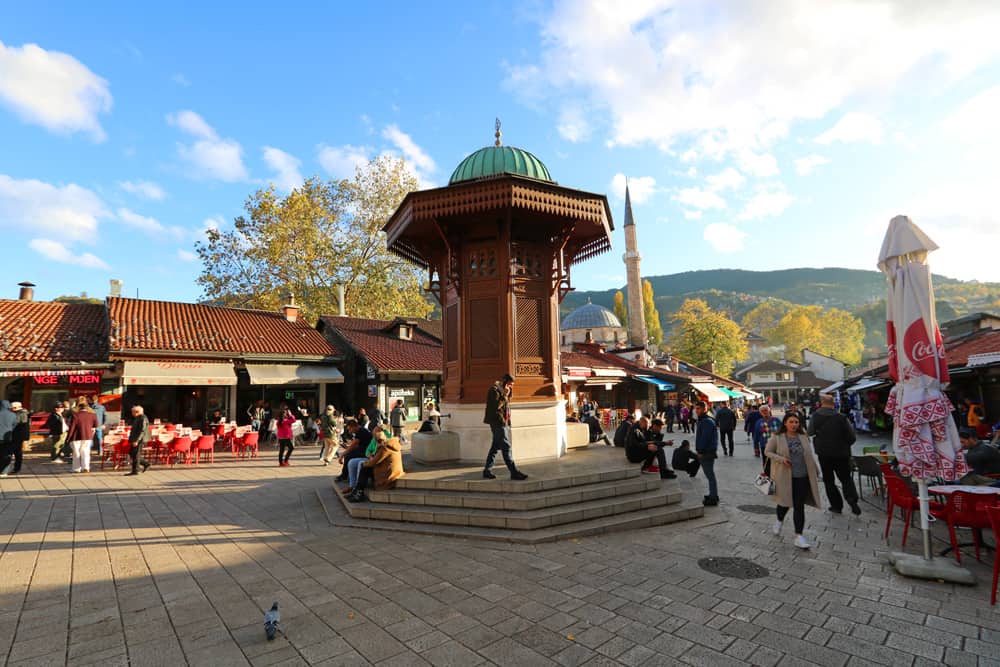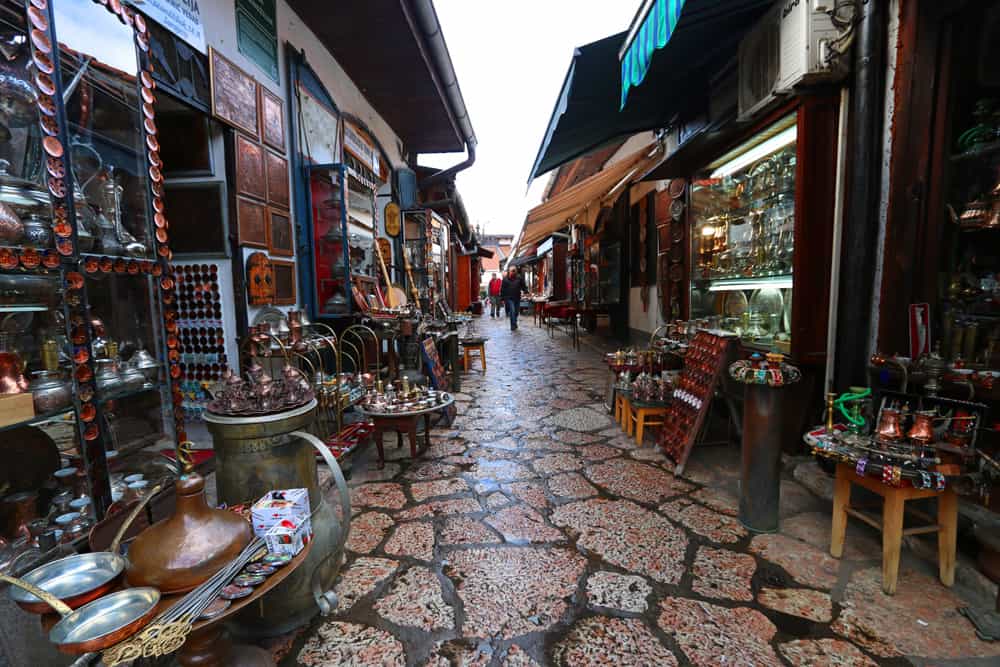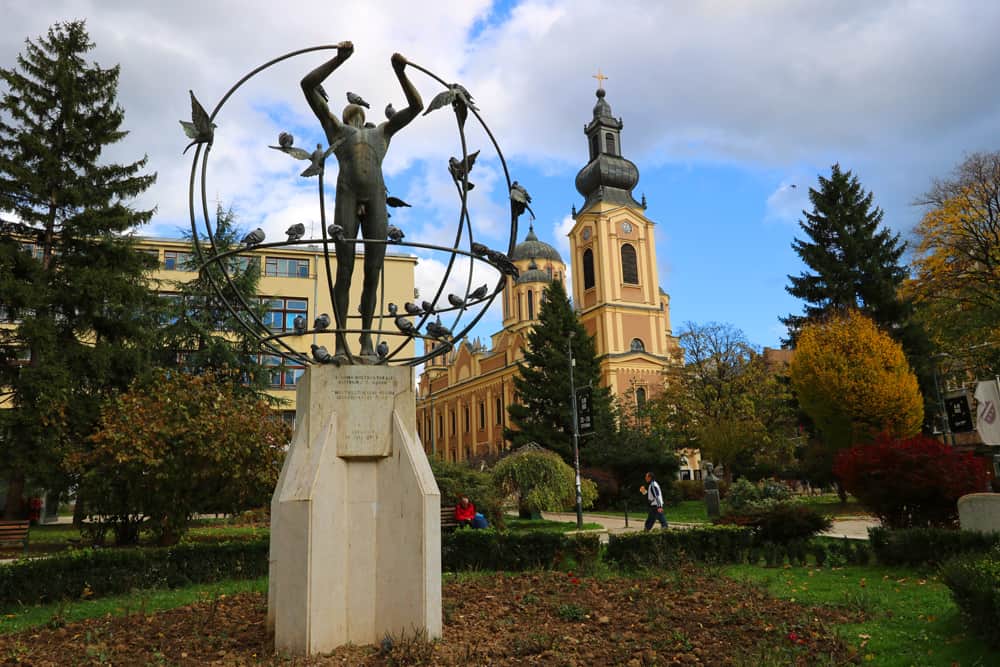Sarajevo and the reasons it’s worth visiting
We’ve been to Sarajevo several times, it’s one of our favorite cities in the Balkans. But it’s more than that – Sarajevo is a city unlike any other in Europe. It’s exotic (you might question whether you are in Europe at all), has a magnificent geographic setting, unique food, affordable pricing, as well as friendly people. Sarajevo is a special place.
This guide to Sarajevo covers everything you need to know about this city – as well as all the reasons why it’s worth visiting.
Geography of Sarajevo
Sarajevo is in a valley and stretches thinly along the Miljacka river, high hills rising along both sides of the city. I like to think of Sarajevo as a city of 4 distinct zones: 1) at the end of the valley (where it’s narrowest), you’ll find the Ottoman-era old town. Walking west (Sarajevo is not big and is easily walkable) you’ll pass the dividing line between east and west at the “Sarajevo meeting of cultures”, an inlaid marker on the main pedestrian street. 2) From this point you’ll see buildings dating from the Austro-Hungarian Empire (churches, present-date government buildings, the national theatre…). This area stretches for about 5 blocks until you get to 3) the more modern part of Sarajevo where you’ll find shopping centers, highrise hotels, museums (including a couple of Sarajevo’s best museums), and the bus and train stations. Going even further west: 4) the city becomes a bit of an urban sprawl of suburbia (there’s nothing really of interest out there except for the Sarajevo Tunnel Museum by the airport).

Where to stay in Sarajevo
The best areas to stay in Sarajevo are in zones 1) and 2) as I’ve described them above. The Ottoman old town and the historic “European” parts of the city have the most points of interest, the best restaurants, and are the most walkable with a long pedestrian-only street (Ferhadija St) intersecting both these zones.
Recommended: Whether budget or fancy, you get good value on accommodations in Sarajevo. Recommendations: Hotel President Sarajevo (high end, perfect location in old town), Hotel Sana (beautiful 4 star hotel, also perfectly located), Hostel Pigeon Square (budget, right in the heart of the Ottoman old town), Hostel Franz Ferdinand (budget, right in the old town).

WHAT TO DO IN SARAJEVO
Highlights of the Ottoman and European Old Town
Starting at the far eastern end of the old town is the City Hall, which stands out with its Moorish-inspired design (the inside is worth a visit) and its attractive location along the river. From there it’s a short walk to the Ottoman-era old town. The Gazi Husrev Beg Mosque is at its center and is said by many to be the finest example of Ottoman architecture in the Balkans. Close by is one of Sarajevo’s most photographed spots: “Pigeon Square” (officially Baščaršija Square). It is the largest square in the Ottoman old town and at its center you’ll see Sebilj, a Moorish-type fountain. This whole area, which spans a few blocks, is full of Ćevapi restaurants, cafés serving Bosnian coffee, and different little alleys dedicated to different crafts (including Kazandžiluk street, also called Coppersmiths’ Alley). You’ll see covered markets, including the covered Brusa Bezisatan (once the main silk market). The area will make you think you are in Istanbul.
Highlights in the Ottoman old Town
Heading a few blocks west on Ferhadija St you’ll pass the Sarajevo meeting of cultures engraving on the pavement. You’ve suddenly moved from Istanbul to Vienna, the buildings and streets around having been built during the times of the Austro-Hungarian Empire. Highlights include the Serbian Orthodox Cathedral, the Catholic Sacred Heart Cathedral, and the Eternal Flame (commemorating victims of World War II in Sarajevo). Wandering closer to the river, you’ll come across the National Theatre. Walk a block down to the river. You’ll see some beautiful buildings, most operating as government buildings. Across the river is the Academy of Fine Arts. A few blocks east is one of Sarajevo’s most famous monuments – the Latin Bridge (where Franz Ferdinand was assassinated in 1914 – leading to World War 1). Crossing the river are more highlights: the Ashkenazi Synagogue (the only active synagogue today), the Emperor’s Mosque, then – just up the hill – the Franciscan church of Saint Anthony of Padua and the Sarajevo Brewery (a great place to go for a beer). Very close by is the Sarajevo Cable Car station. From here a cable car will take you up Mount Trebević. Up above is the Sarajevo Viewpoint (for the best views of the city). There are some walking trails up here giving you differing views of the city. Also very close (an easy walk) is the Bobsled track that was used in the 1984 Sarajevo Olympics. People like to come here to take photos of the colorfully-graffitied track, a sad reminder of better days.
Highlights in the European Old Town
On the slopes on the opposite side of the old town (accessed from Pigeon Square) are a few other highlights. One is the Kovači Memorial Cemetery, the main cemetery for soldiers killed during the Bosnian War in Sarajevo: April 1992 – December 1995). Continue up the hill to your right. It will bring you to the Yellow Fortress. It’s more of a bastion than a fortress and it’s not yellow…but it has some of the best views of the city (see the photo at the very top of this post). If you want more views you can continue up, through a maze of streets, to the White Fortress for more great views. You’ll have to pay however and the White Fortress isn’t really that impressive. I don’t recommend it…

I’ve thrown a lot of things at you above. I really recommend a walking tour of Sarajevo – it will help you get orientated, you’ll get tons of information that I can’t fully cover here, plus it’s really inexpensive.
Highlights in Sarajevo’s modern city center
This is zone 3 that I mentioned up above. In this area you’ll find shopping centers, highrise hotels, museums (including a couple of Sarajevo’s best museums), and the bus and train stations. There’s more than that however.
The Avaz Twist Tower is the highest tower in all the Balkans. Great views from up top. (It is located right next to the train station which is worth a quick look. Trams 1 and 4 go there from Pigeon Square). Not far from the train station, on the main boulevard (you’ll be walking past the huge American Embassy to get there), is the National Museum. It is the best museum in the city. Lots of Roman artifacts (Bosnia was part of the Roman province of Illyricum starting in 136 BC), an ethnology building where they’ve recreated the traditional interior settings of Muslim homes, and what the museum is most famous for – the Jewish Haggadah, a text that came from Barcelona when the Jews were forced to leave Spain in 1492.
If looking for a place to have a coffee or beer after the Museum, go to Caffe Tito which is right next door. It has some old tanks and military equipment on the grounds, inside it’s full of old Yugoslav memorabilia.
This part of Sarajevo is also known because it was the hardest hit during the Bosnian War and the resulting siege of Sarajevo. The main boulevard was known as “Sniper Alley” because it was the target of snipers and mortar fire from Serbs holed up in close by buildings and nearby hills. You’ll see Hotel Holiday – which at the time was the Holiday Inn – the place foreign correspondents stayed while covering the war. Right next to it are two twin towers. They were the target of a lot of artillery during the war (I have a detailed post on Sarajevo during the war – with photos – here: Why Sarajevo is a Microcosm of everything that’s wrong with the Balkans). Walk around and you’ll see red splotches on the ground – these indicate where people died because of mortars or sniper fire.
I really recommend you take a tour to better understand what happened in Sarajevo during the war. The “Sarajevo Under Siege War Tour” is worth it because they’ll take you to places you can’t get to on your own including the Sarajevo Tunnel Museum (which I cover below), some war sites on Mount Trebević (including the before-mentioned Bobsled track), as well as a few spots that the Serbs used to fire on the citizens of Sarajevo from the hills (you’ll see central Sarajevo from a whole different vantage point – and understand how exposed Sarajevo was to attacks from nearby mountains).
Sarajevo Tunnel Museum
The Sarajevo Tunnel is the focus point of any “Siege” tour. When the city was laid under siege by the Serbs, the UN struck a deal with them allowing essential supplies (ie. food) to come in by way of the airport. But many other things were lacking.
The airport bordered onto free Bosnian territory, which was across from the runway. There was no access because of Serb sniper fire, so the Bosnian army dug a 960 m (3,150 ft) tunnel that connected Sarajevo to the safe Bosnian territory that lay beyond the control of the Serbs. Through that tunnel they brought in supplies (like weapons and artillery) but also fuel and electricity.
On the Sarajevo side, the tunnel started at a house (all pockmarked by bullet holes) next to the airport. That’s the site of the present day museum which details the siege of Sarajevo (which lasted from April 1992 to December 1995. You’ll also be able to walk through a section of tunnel to get an idea what it was like for soldiers carrying supplies through. For anyone with an interest in history it’s an essential part of any visit to Sarajevo.
Note: another war related museum that you shouldn’t miss is the War Childhood Museum close to Sarajevo’s old town. It’s not a large museum, it’ll probably take you an hour. It’s sobering. Bring some Kleenex.
Food and Restaurants
When I think of Sarajevo (and Bosnia) I think of 3 things: Ćevapi (a grilled dish of minced meat), Blatina wine (Bosnia’s best wine, from the Herzegovina region), and Rakija (a fruit brandy – in all sorts of flavours and strengths – popular in the Balkans). You have to experience all 3 if visiting Sarajevo.
Recommended Restaurants
Luka restaurant. One of Sarajevos’s best restaurants with traditional food as well as excellent seafood. Situated near the Academy of Fine Arts.
Ascinica Stari Grad. Very good, traditional, simple, and inexpensive Bosnian food.
Pirpa. Very good fast food.
Noovi. Excellent Italian restaurant (with pizza) and wine bar.
Getting to Sarajevo
Train: Sarajevo is no longer connected to any of its neighbors by train. It does have an excellent train to Mostar however (one of the Balkan’s best and most scenic routes). More here: Taking the train from Sarajevo to Mostar
Bus. The main bus station (next to the train station) has buses going to Croatia (Split and Dubrovnik), Mostar, Austria (Graz and Vienna), as well as Pristina in Kosovo. A 2nd bus station (‘Lukavica’) covers primarily destinations in Serbia (Belgrade, Novi Sad, and Nis) and Montenegro (Podgorica and Budva).
Air. Sarajevo doesn’t have the greatest air connections but airlines like Lufthansa, Austrian Airlines, Turkish Airlines, Air Serbia, and Croatia Airlines have flights. A recent new airline flying into Sarajevo is Wizz Air from Budapest (which I found very affordable). The airport is Sarajevo International Airport (code: SJJ)
Related: Comparing and rating our favorite Balkan capitals
Related: Why Visit Yerevan? And why it’s proof that people don’t know what they’re talking about…
Related: 3 Days in Istanbul
Ps. If you find our blog helpful, please consider using our links to book your flights, hotels, tours, and car rentals. Have a look at our Travel Resources page.
















Oh yes, Sarajevo (and Mostar) are on my list!
Thanks for reigniting my wanderlust. It kind of fizzled out for a bit with all this … you know.
I am thankful we got to travel around with the kids these past years. The unknown future makes me a bit sad. Which is still a bit silly because the future has always been like that.
Thanks for sharing your travels Frank!
Colleen
Sarajevo and Mostar both very interesting and very different from other places in the region. Between the two cities you should take the train. I’ll have a post about that in the next little while.
Yes, we’ve been very much wondering about the future as well. Makes us realize just how lucky we’ve been travelling full-time the last 6 years.
I hope you are well Colleen 🙂
In your opinion, do you think Sarajevo would be a good place to stay for a month? My partner and I are trying to find two cities in the Balkans to do month stays at and we’ve really been liking the idea of Bosnia and Herzegovina. I’ve read some blogs that said there isn’t much to do in Sarajevo, so I’m a bit hesitant before booking a rental.
For a long-term stays, I would recommend Split in Croatia and Sarajevo. It’s true that there’s not a ton to do in Sarajevo, but it’s an interesting and exotic city (and very inexpensive city). Culturally it’s very interesting and we find the people very friendly. Really, if you’re talking about month-long stays there aren’t too many cities in the Balkans other than Split, Sarajevo and maybe Belgrade where I’d want to stay a month. We wrote a post on our favorite Balkan capitals which might help also.